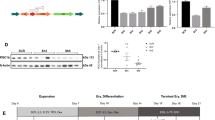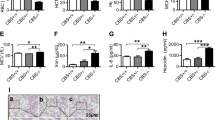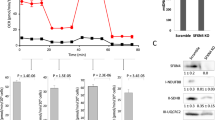Abstract
Hemoglobin deficit (hbd) mice carry a spontaneous mutation that impairs erythroid iron assimilation but does not cause other defects. Normal delivery of iron to developing erythroid precursors is highly dependent on the transferrin cycle. Through genetic mapping and complementation experiments, we show that the hbd mutation is an in-frame deletion of a conserved exon of the mouse gene Sec15l1, encoding one of two Sec15 proteins implicated in the mammalian exocyst complex. Sec15l1 is linked to the transferrin cycle through its interaction with Rab11, a GTPase involved in vesicular trafficking. We propose that inactivation of Sec15l1 alters recycling of transferrin cycle endosomes and increases the release of transferrin receptor exocytic vesicles. This in turn decreases erythroid iron uptake. Determining the molecular basis of the hbd phenotype provides new insight into the intricate mechanisms necessary for normal erythroid iron uptake and the function of a mammalian exocyst protein.
This is a preview of subscription content, access via your institution
Access options
Subscribe to this journal
Receive 12 print issues and online access
$209.00 per year
only $17.42 per issue
Buy this article
- Purchase on Springer Link
- Instant access to full article PDF
Prices may be subject to local taxes which are calculated during checkout



Similar content being viewed by others
References
Hentze, M.W., Muckenthaler, M.U. & Andrews, N.C. Balancing acts: molecular control of mammalian iron metabolism. Cell 117, 285–297 (2004).
Trenor, C.C. III, Campagna, D.R., Sellers, V.M., Andrews, N.C. & Fleming, M.D. The molecular defect in hypotransferrinemic mice. Blood 96, 1113–1118 (2000).
Levy, J.E., Jin, O., Fujiwara, Y., Kuo, F. & Andrews, N.C. Transferrin receptor is necessary for development of erythrocytes and the nervous system. Nat. Genet. 21, 396–399 (1999).
Bannerman, R.M., Garrick, L.M., Rusnak-Smalley, P., Hoke, J.E. & Edwards, J.A. Hemoglobin deficit: an inherited hypochromic anemia in the mouse. Proc. Soc. Exp. Biol. Med. 182, 52–57 (1986).
Garrick, L.M., Edwards, J.A., Hoke, J.E. & Bannerman, R.M. Diminished acquisition of iron by reticulocytes from mice with hemoglobin deficit. Exp. Hematol. 15, 671–675 (1987).
Bloom, M.L., Simon-Stoos, K.L. & Mabon, M.E. The hemoglobin-deficit mutation is located on mouse chromosome 19. Mamm. Genome 9, 666–667 (1998).
Andrews, N.C. Iron homeostasis: insights from genetics and animal models. Nat. Rev. Genet. 1, 208–217 (2000).
Grindstaff, K.K. et al. Sec6/8 complex is recruited to cell-cell contacts and specifies transport vesicle delivery to the basal-lateral membrane in epithelial cells. Cell 93, 731–740 (1998).
Lipschutz, J.H. et al. Exocyst is involved in cystogenesis and tubulogenesis and acts by modulating synthesis and delivery of basolateral plasma membrane and secretory proteins. Mol. Biol. Cell 11, 4259–4275 (2000).
Yeaman, C., Grindstaff, K.K. & Nelson, W.J. Mechanism of recruiting Sec6/8 (exocyst) complex to the apical junctional complex during polarization of epithelial cells. J. Cell Sci. 117, 559–570 (2004).
Zhang, X.M., Ellis, S., Sriratana, A., Mitchell, C.A. & Rowe, T. Sec15 is an effector for the Rab11 GTPase in mammalian cells. J. Biol. Chem. 279, 43027–43034 (2004).
Friedrich, G.A., Hildebrand, J.D. & Soriano, P. The secretory protein Sec8 is required for paraxial mesoderm formation in the mouse. Dev. Biol. 192, 364–374 (1997).
Murthy, M., Garza, D., Scheller, R.H. & Schwarz, T.L. Mutations in the exocyst component sec5 disrupt neuronal membrane traffic, but neurotransmitter release persists. Neuron 37, 433–447 (2003).
Andrews, H.K., Zhang, Y.Q., Trotta, N. & Broadie, K. Drosophila Sec10 is required for hormone secretion but not general exocytosis or neurotransmission. Traffic 3, 906–921 (2002).
Mehta, S.Q. et al. Mutations in Drosophila sec15 reveal a function in neuronal targeting for a subset of exocyst components. Neuron 46, 219–232 (2005).
Brymora, A., Valova, V.A., Larsen, M.R., Roufogalis, B.D. & Robinson, P.J. The brain exocyst complex interacts with RalA in a GTP-dependent manner: identification of a novel mammalian Sec3 gene and a second Sec15 gene. J. Biol. Chem. 276, 29792–29797 (2001).
Guo, W., Roth, D., Walch-Solimena, C. & Novick, P. The exocyst is an effector for Sec4p, targeting secretory vesicles to sites of exocytosis. EMBO J. 18, 1071–1080 (1999).
Ren, M. et al. Hydrolysis of GTP on rab11 is required for the direct delivery of transferrin from the pericentriolar recycling compartment to the cell surface but not from sorting endosomes. Proc. Natl. Acad. Sci. USA 95, 6187–6192 (1998).
Ullrich, O., Reinsch, S., Urbe, S., Zerial, M. & Parton, R.G. Rab11 regulates recycling through the pericentriolar recycling endosome. J. Cell Biol. 135, 913–924 (1996).
Savina, A., Fader, C.M., Damiani, M.T. & Colombo, M.I. Rab11 promotes docking and fusion of multivesicular bodies in a calcium-dependent manner. Traffic 6, 131–143 (2005).
Harding, C., Heuser, J. & Stahl, P. Receptor-mediated endocytosis of transferrin and recycling of the transferrin receptor in rat reticulocytes. J. Cell Biol. 97, 329–339 (1983).
Harding, C., Heuser, J. & Stahl, P. Endocytosis and intracellular processing of transferrin and colloidal gold-transferrin in rat reticulocytes: demonstration of a pathway for receptor shedding. Eur. J. Cell Biol. 35, 256–263 (1984).
Johnstone, R.M., Mathew, A., Mason, A.B. & Teng, K. Exosome formation during maturation of mammalian and avian reticulocytes: evidence that exosome release is a major route for externalization of obsolete membrane proteins. J. Cell. Physiol. 147, 27–36 (1991).
Savina, A., Vidal, M. & Colombo, M.I. The exosome pathway in K562 cells is regulated by Rab11. J. Cell Sci. 115, 2505–2515 (2002).
Scheufler, H. Eine weitere Mutante der Hausmaus mit Anamie (hbd). Z. Versuchstierkd. 11, 348–353 (1969).
Torrance, J.D. & Bothwell, T.H. Tissue Iron Stores (Churchill Livingstone, New York, 1980).
Chen, J. et al. Constitutively activated FGFR3 mutants signal through PLC{gamma}-dependent and -independent pathways for hematopoietic transformation. Blood 106, 328–337 (2005).
Schwaller, J. et al. Stat5 is essential for the myelo- and lymphoproliferative disease induced by TEL/JAK2. Mol. Cell 6, 693–704 (2000).
Zhang, J. & Lodish, H.F. Constitutive activation of the MEK/ERK pathway mediates all effects of oncogenic H-ras expression in primary erythroid progenitors. Blood 104, 1679–1687 (2004).
Acknowledgements
We thank C. Roy and T. Holm for sharing unpublished data; A. Donovan, J. Glaven, D. Wrighting and R. Ohgami discussing experiments and commenting on the manuscript; G. Gilliland for assistance with BMT experiments; and Y. Fujiwara for blastocyst injections. This work was supported by a March of Dimes research grant and a grant from the US National Institutes of Health to N.C.A. NCA is also an investigator of the Howard Hughes Medical Institute.
Author information
Authors and Affiliations
Corresponding author
Ethics declarations
Competing interests
The authors declare no competing financial interests.
Supplementary information
Supplementary Table 1
Oligonucleotides used as PCR primers for analysis of Sec15l1. (PDF 57 kb)
Rights and permissions
About this article
Cite this article
Lim, J., Jin, O., Bennett, C. et al. A mutation in Sec15l1 causes anemia in hemoglobin deficit (hbd) mice. Nat Genet 37, 1270–1273 (2005). https://doi.org/10.1038/ng1659
Received:
Accepted:
Published:
Issue Date:
DOI: https://doi.org/10.1038/ng1659
This article is cited by
-
Neonatal lethality and recycling defect of transferrin receptor in mice with Syntaxin12/13 disruption
Protein & Cell (2019)
-
Regulation of heme biosynthesis and transport in metazoa
Science China Life Sciences (2015)
-
Phenotypic and functional consequences of haploinsufficiency of genes from exocyst and retinoic acid pathway due to a recurrent microdeletion of 2p13.2
Orphanet Journal of Rare Diseases (2013)
-
Disruption of EXOC6B in a patient with developmental delay, epilepsy, and a de novo balanced t(2;8) translocation
European Journal of Human Genetics (2013)
-
Exocyst function regulated by effector phosphorylation
Nature Cell Biology (2011)



